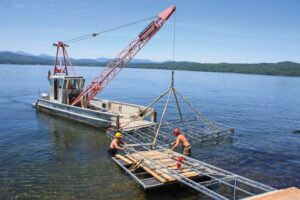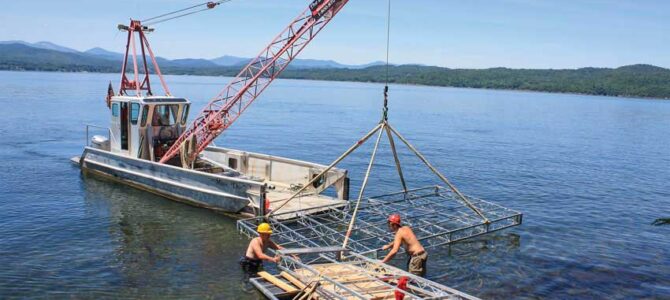A sturdier dock means a safer waterfront for your family. Whether you’re building a conventional or floating dock, it’s essential to use suitable materials to ensure its longevity. For example, hot-dipped galvanized fasteners are a must to avoid rusting.
To install the first section, float or carry it to its location and place it on the bracket. Slide the next standard assembly onto the pipe and about to the other side of the previous section. Click Here for more details.
Whether you have a conventional dock with posts that screw into the lake bottom or a floating dock you need to have some type of support system to anchor your dock. The most common support technology used by cottage owners is augers. There are a number of different auger styles and designs available from FLOE which allows you to choose the auger that works best with your particular bottom conditions.
If your lake bottom is very dense and does not allow for much penetration you may want to employ a mud auger that allows you to get a lot of traction in the lake bed. A mud auger essentially sits on the lake bottom and grabs onto it to hold your dock in place. If you have a rocky lake bottom you can also use a base pad that is designed to work in these types of conditions. Base pads come in a variety of shapes and sizes, cupped, square, and rectangular with many of these options featuring holes or spaces within the body of the pad to increase its “grip”.
Once you have an auger installed into one end of your dock pipe, loosen the leg lock bolts and lower your new dock section into the water. Using the auger wrench, turn the auger into the dock pipe until it is secured in your lake bottom. Then tighten the leg lock bolts.
Repeat this process with the rest of your new dock sections. Once you have your entire dock assembled you can add 3′ powder coated decorative post covers which snap on to the end of the dock pipes. If you have dock pipes that extend more than 34″ above the deck, you can also cut them with a saw or pipe cutter to the proper length for your specific dock layout.
Now that your basic dock is assembled it is time to enjoy your waterfront! You will want to float your dock for a few days to make sure it is level before you add the black post caps. Lastly, we recommend marking the bracket sleeve on each of your dock sections with a magic marker so that next year you know which section to put in first.
Alumi-Span’s Large Bottom Plates
In order to have a successful dock you need a system that not only works well but is also easy to install. The biggest thing is that the sections have to be light. If the sections aren’t light the installation is going to be a huge pain and will take a long time. Old splintery, hot all-wood dock sections typically weigh 200 – 250 pounds and even more when they’re wet. If you can afford it we recommend switching to aluminum or vinyl dock sections. Our maintenance free aluminum and cedar options still have the look of traditional stained wood but don’t require any of the sanding or painting.
If you’re on a lake that has a muck bottom installing the dock in the conventional manner means augering it in until it hits something solid which can be difficult and costly. The best way to deal with muck bottoms is to use large bottom plates. These plates allow the post to sink down through the muck but they don’t stop there so that you can get your dock up on the soft bottom.
These plates can clamp anywhere up and down the post (no unreliable thumb screw) and are available in many different sizes for a wide variety of situations. You can even get them in a “two piece” casting which allows you to push the dock pole in a bit further on mucky situations.
A large plate can be installed just as you would a permanent auger but it’s much easier since there is no digging to do. We like to start the process by loosening the bolts that hold the stringer brackets on each end of the crossarm. Then we put the first standard assembly on the bottom of the plate and slide the next section over it. This gives you a good idea of where the dock is and can help avoid getting it in the wrong place.
Once the standard assemblies are on the bottom of the plates you can lift up the top section of your dock and slide it on to the bottom plate and tighten the carriage bolts. You’ll then want to float the section out to the water to finish the rest of the assembly or carry it in on a boat.
Alumi-Span’s Floating Dock
A floating dock is a staple for many waterfront properties. It can increase a property’s value, provide safe boat and water access, and help improve the experience for those who use wheelchairs or have mobility challenges. However, the dock’s installation can be a daunting task for those without professional help. Some people even pay others to do their dock installation so they don’t have to deal with the backbreaking heavy lifting that goes along with it.
Docks can be made of a variety of materials, each with its own benefits and drawbacks. For example, all-aluminum and vinyl docks are the lightest and most maintenance free. They are also a good choice for residential properties. But some people prefer the look of cedar or treated pine. In fact, Alumi-Span offers a hybrid cedar-aluminum option that saves money while providing the durability of an aluminum dock.
The material you choose should also be based on where you are going to install your dock. The type of property you have will determine the amount of space you can use as well as any governmental restrictions or fees related to the dock structure. The location will also inform what accessories and features are a good idea, such as safety railings on exceptionally rough or deep waters, or storage boxes, benches, or ladders in recreational settings.
Another thing to keep in mind is how easy your new dock will be to assemble and disassemble for winter. A lift dock is a great solution for situations where ice movement may cause damage to your existing dock. It is a deck style platform that hinges to the land and has a set of stairs to allow you to get down to the water level. It then cranks up for the winter to reduce ice movement.
Lastly, it is important to find out how much your local government or homeowner’s association requires for dock construction and placement. Some jurisdictions require permits and have specific guidelines for sizes, types, and materials of the dock. These requirements should be taken into account as they will have a significant impact on the final cost of the dock and installation.
Alumi-Span’s Conventional Dock
Many homeowners who purchase dock sections are looking for something a bit more conventional than the Perma Augers or Floating Dock. They are looking for a dock that will stand up to the elements and withstand normal wear and tear. If that is the case for you, Praklet’s Piers and Lifts has the solution: Alumi-Span’s Conventional Dock.
The basic components of this style of dock are aluminum, so they will withstand the weather without rusting or warping. Alumi-Span’s Conventional dock also offers a variety of different finishes to help you achieve the look you desire for your waterfront property. From a basic aluminum to the darker wood grain appearance, you can find what you need with this type of dock section.
One of the best things about this style of dock is that it works well in shallow water depths. The minimum amount of water needed to put in this type of dock is three or four feet. This is a great option for people who live on an inland lake and want to avoid the hassle of putting in a dock in deep water, which can be challenging for those who are using waders or a boat.
A conventional dock from Alumi-Span is constructed with a standard end section, which features a hook on the side that attaches to the lip on the previous dock section. The standard end section is then repeated to create the straight run of your dock layout. This is the most commonly used section in a dock layout, and it provides the structure for the entire platform.
Another feature of the standard end section is that it includes a mounting plate, which can be placed on top of a dock post. This is a very useful feature, especially for people who live in areas that are prone to severe storms. This mounting plate prevents the dock from moving on the surface of the water during storms, and it also helps to reduce the risk of the foundation becoming weakened or damaged.
When the time comes to replace your dock, it is important to be aware of possible problems so that you can address them in a timely manner. For instance, foundation deterioration is not only dangerous, but it could also lead to the entire dock coming crashing down into the water at the slightest nudge. In cases where the foundation is seriously compromised, it may be necessary to have a total replacement of the entire dock.
